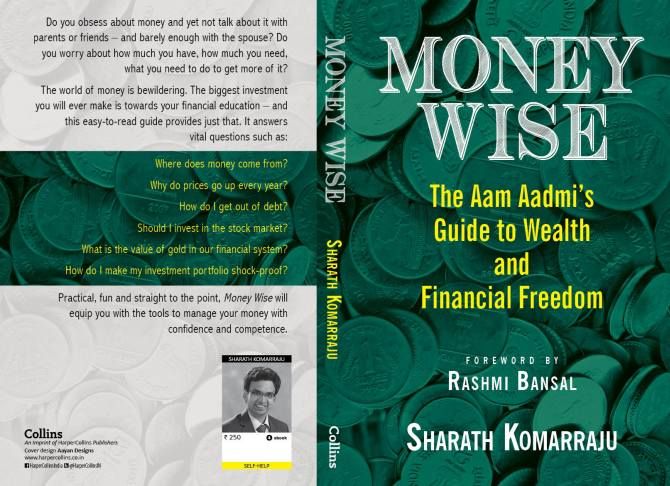It's just not stocks and mutual funds that help you make good profits in the long run, says Sharath Komarraju, author of Money Wise which, he says, is 'Aam Aadmi's guide to wealth and Financial Freedom'.

Photograph:401(K) 2012/Wikimedia Commons
From writing software codes to writing fiction and non-fiction, author Sharath Komarraju, has come a long way.
Komarraju's first novel, Murder in Amaravati, was longlisted for the Commonwealth Book Prize 2013. His best known work is the Winds of Hastinapur, the first book in a series that attempts to tell the Mahabharata from the viewpoints of all the prominent women characters.
His other fiction books include Banquet on the Dead and The Puppeteers of Palem.
Money Wise -- Komarraju's fourth book and his first attempt at non-fiction -- is what he says is 'Aam Aadmi's guide to wealth and Financial Freedom'.
We produce an excerpt from the book.
***
THE STORY OF bonds begins in sixteenth-century Europe, a little after the Reformation. The new little Dutch Republic was locked in an eighty-year war of liberation with the mighty Spanish empire. They needed money to pay German mercenaries to fight for them against the Spanish. Their only option was to borrow money from a third country to pay for their war, but they knew that would drive them into another form of slavery. So they came up with a financial innovation that had been unheard of till then.
Up until that point, credit was frowned upon, and if one wished to borrow money, the only option was to discreetly approach a moneylender. Loans had always been a transaction between two parties, a lender and a borrower. What the Dutch asked was a fundamental question: can an entity that does not
have access to a lender still borrow money? All financial models that existed until then said that such a thing was impossible. If you wanted to borrow money and no one wanted to lend, from whom would you borrow? The answer was so elementary that it defied belief: if you could not find someone to borrow money from, why, you just borrowed from yourself, idiot.
And so, in 1609, the Bank of Amsterdam was born.
The modus operandi was simple: the bank would take a loan from Dutch citizens, and in return, it would give the creditor a guarantee of a fixed rate of return every year for the rest ofeternity. In this transaction, money flowed from the people to the bank, and guarantees flowed from the bank to the people.
It was a win-win for both parties: the bank raised all the money the country needed to oust the Spanish empire, and the people found an investment that would pay them a set amount of interest for the rest of their lives and beyond.
Since there was no time limit to these agreements between the bank and its people, they were called perpetual bonds.
In the meantime, the Spanish empire was tied to the old way of debt (where some other country had to loan you money), and was crumbling due to the lack of funds. The Dutch raised so much money with their financial innovation that they won the war of liberation, became a new republic, and paved the future of the global financial system.
The model was so simple that it did not take long to catch on.
Today, bonds abound everywhere, and are issued by everybody, from governments to corporations to people.
Sometimes the language used in relation to bonds can make them hard to understand, but at its core, a bond is just a loan, and if you understand the concepts of borrowing, lending, and interest rates, you can understand bonds with no problem at all.
So, shall we begin?
What Is a Bond?

In a short, simple, snappy sentence, a bond is the receipt of a loan that a borrower gives a lender.
For example, if I were to give you a loan of 5000 rupees, we will together sign a bond on which are written the terms and conditions of the loan: more specifically, the bond will contain details about the maturity date of the loan and the rate of interest that you should pay me for the duration. That's all a bond is.
It is a receipt that you give me confirming that I have given you a loan.
All loans require collateral. For instance, in the loan that I give you, perhaps you will place an expensive piece of jewellery that you own as collateral, so that if you default on your loan, I can keep your collateral and retrieve my funds from selling it.
The bond will contain details of this too.
When governments issue bonds to citizens, the collateral they offer is their ability to tax citizens in the future. Since the only revenue for governments is through taxation, their ability to pay back their loans hinges solely on their ability to tax their people. As long as the country exists and a functional government sits on top of it, there is no risk to interest payments or capital. This 'guarantee', that the repayment of your loan is assured as long as the government functions, is called a sovereign guarantee. In India, Government bonds come with this sovereign guarantee, and is the highest safety rating afforded to any investment class.
Broadly speaking, there are two different kinds of bonds that are available to the common investor. They are:
- Government bonds
- Corporate bonds
We will limit our discussion first to government bonds only, because all bonds are basically variants of the main concept with little differences in practice.
A layer of complexity arises in the bond market from the fact that all government bonds are 'marketable', which means that you can sell them to another investor without involving the government. So there are two markets here: a primary market, where the government sells bonds to an investor,
and a secondary market, where the bonds are sold and bought between investors without the interference of the government.
The government simply pays the owner of the bond a certain amount as interest at regular intervals, as defined in the terms of the bond. For this reason, it is called a 'fixed income' instrument because, in theory, the income in bonds comes only from the interest payment that the government makes to the owner. It is also called a 'debt' instrument because, after all, the government is in the bond owner's debt.
However, in practice, bond investors get an additional source of income besides the fixed interest. This happens because of the secondary market, where the price of the bond could sell for more or less than its original amount. So there is a possibility of capital gain as well for the bond investor. To delve a little further into this, we must understand interest rates and how bonds respond to them.
Capital Gains (and Losses) in Bonds
Let's take the Reserve Bank of India and Government of India as examples to illustrate this. We're doing this only for familiarity; the concept stays the same for practically any country in the world today that is run by a central bank.
The Reserve Bank of India has the power to raise and quell interest rates as it sees fit to balance the economy. This is basically the rate at which it will lend funds to all banks under it, so that will automatically alter every interest rate in the market.
So let's assume that at the beginning of Year 1, you bought a twenty-year bond of 1000 rupees from the government at an interest of 7 per cent.
Today you're quite happy with the choice, because you've looked around the market and have found out that no other investment vehicle gives you that high a return on that low a risk.
However, later that year, say the RBI raises the interest rate by 1 per cent. Now, the interest rate on the government bond that is issued after the rate rise will be 8 per cent. Notice that your bond, which you bought earlier in the year, is only giving a 7 per cent return. When new bonds from the same borrower are available at 8 per cent, why would anyone buy your 7 per cent bond? So if you wish to sell your bonds and raise money for an emergency, what is your option?
People will still buy your bond but only if the yield on it matches the yield on the new bond. So if the price of your bond drops adequately to cover for the 1 per cent gap, then you will be able to find buyers. So you lower your selling price of the bond and offer it to buyers in the secondary market at a discount so that the new owner will generate a return of approximately 8 per cent from your bond also. In this case, the price would be about 875 rupees. So if you sell your bond after rates rise, you will make a capital loss.
The reverse is true if the RBI drops interest rates, say by 1 per cent again. Now the interest rate on new bonds will be 6 per cent, and your 7 per cent bond will look very attractive to new investors. The price on your bond, therefore, will go up in value until the 1 per cent gap is again filled, and the price of your 1000-rupee bond will be approximately 1166 rupees. If you sell at this price, you will make a capital gain.
So bonds are inextricably linked to the interest rate cycle.
However, all this is relevant only if you plan to sell the bond at any time. If you intend to hold the bond till maturity, for the whole twenty years as in the case of the example above, you will continue to get your 7 per cent interest payments regularly, and at the end of the loan period, you will get your 1000 rupees back. Capital gains and losses become relevant only when you consider participating in the secondary market.
This makes speculation a fair part of the game. If you think the RBI is going to raise rates in the following cycle, you will sell your bonds and be ready to snap them up at cheaper prices in the future. If you think the RBI is going to drop rates, then you will buy more bonds and position yourself for an appreciation in market value. So while the assets are called 'Fixed Income', in practice, income from bonds is anything but fixed and is a mixture of interest payments, capital gains, and losses.
A common question that plagues bond investors is whether they should capitalise on their bonds' market values, or whether they should sit tight and ride the storm to maturity. The answer is that it depends. What if you bought a 9 per cent bond five years ago and the interest rates today are 12 per cent? Will you be happy getting a 9 per cent return when everyone around you is getting 12 per cent? On the other hand, what if the interest
rates have dropped to 6 per cent? Will you be able to sit on the gain in the value of your bonds, knowing fully well that in the next year, the rates may go back up to 9 per cent and wipe out all your profits?
These are questions of psychology and character, and each investor answers them differently. The more daring among us may sit tight and ride the storm when interest rates rise and bond values plummet. Others will sell and run. Yet others will buy more, convinced that rates will return to 'normal'. What you will do, then, depends on you. The important thing to realise is that while they're low risk in terms of capital protection, bonds are by no means non-volatile. Many first-time bond investors enter the market thinking that low risk means low volatility and find themselves surprised at how much the market value of their bond fluctuates.
Remember: bonds offer safety from capital erosion, not from volatility. If market prices going up and down from one day to the next make you nervous, you should either refrain from buying bonds or from watching the markets closely.
Excerpted with kind permission from Collins, an imprint of HarperCollins publishers









